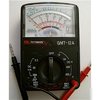inspectweld
Member
I have tested for spark on my plugs and I have no spark. Tried cleaning and then replacing the points and condenser and replacing the coil. Still no fire on the plugs. Any help- would be appreciated.
On the plus side of coil with key on I get 30 volts and while cranking I get a draw down to 25 volts and it holds steady at that voltage.
Neg. side of coil with key on I get 1 volt and while cranking I get a pulse from 1 to 2 volts.
Just out of curiosity I disconnected the neg coil wire from the connection to the condenser wire on the points and I now get 30 volts on that connection and at the neg. terminal of the coil.
With that wire still disconnected when I crank the motor it draws down to 25 volts and holds steady. On the positive side of the coil with the key on it does the same thing, I get 30 volts and it draws down to 25 volts and holds steady
On the plus side of coil with key on I get 30 volts and while cranking I get a draw down to 25 volts and it holds steady at that voltage.
Neg. side of coil with key on I get 1 volt and while cranking I get a pulse from 1 to 2 volts.
Just out of curiosity I disconnected the neg coil wire from the connection to the condenser wire on the points and I now get 30 volts on that connection and at the neg. terminal of the coil.
With that wire still disconnected when I crank the motor it draws down to 25 volts and holds steady. On the positive side of the coil with the key on it does the same thing, I get 30 volts and it draws down to 25 volts and holds steady
Last edited:

